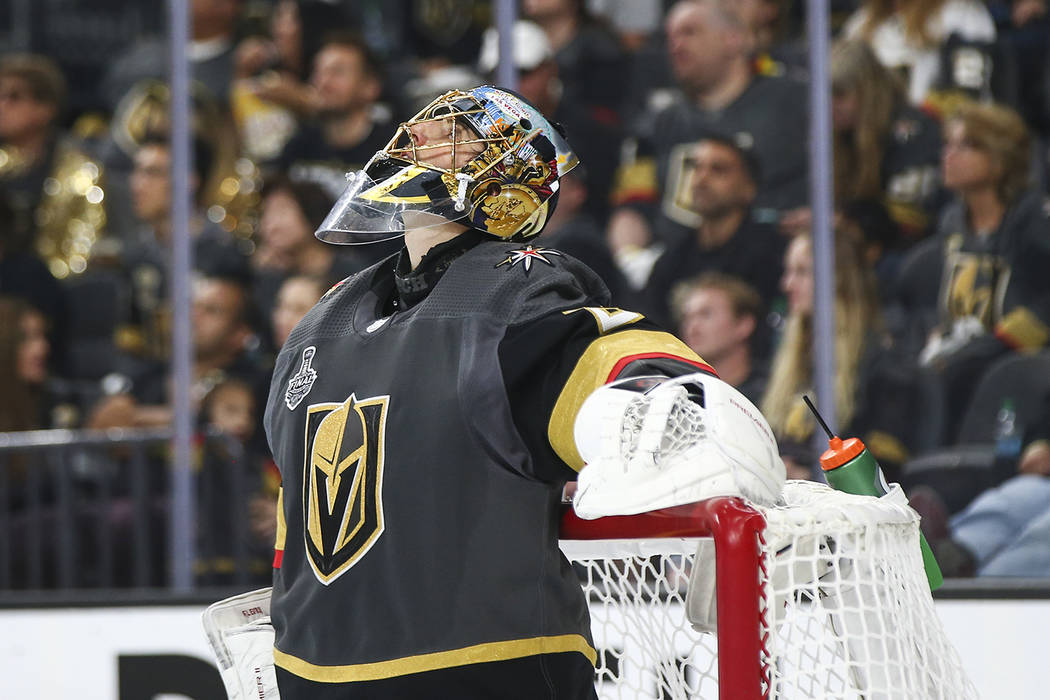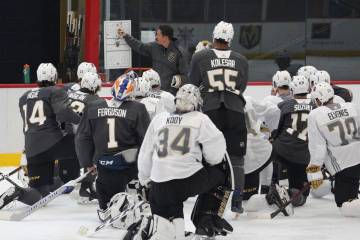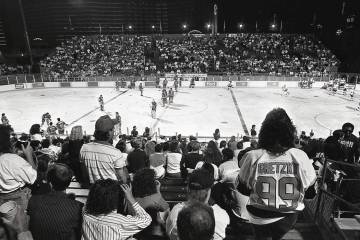Knights’ Fleury braces for NHL’s latest change to goalie equipment
Marc-Andre Fleury can find the positive in just about any situation.
Starting this season, Fleury and his fellow NHL goaltenders will be wearing narrower chest and arm protectors. The changes were made, in part, with goal scoring — not puck stopping — in mind.
But the Golden Knights netminder sees at least one advantage.
“Everything moves better. I can comb my hair back, right?” Fleury said as he ran his fingers through his dark brown locks.
The new regulations governing the chest and arm protectors are the latest in a series of moves by the league designed to shrink goaltenders’ equipment.
Leg pads were reduced starting with the 2010-11 season and new regulations were implemented in 2013 to make the pads directly proportional to the height of the player.
The league’s competition committee revisited the issue in the summer of 2015 and rules to streamline goaltenders’ gear were approved by the board of governors the following year.
“The whole thing was, try to make equipment that mimics the shape of the body that it’s protecting … (while) never reducing protection,” Kay Whitmore, the NHL’s senior director of hockey operations for goaltending-related issues, told NHL.com. “We’ve tried to remove equipment from areas there’s no body part behind.”
Pants were the first piece to be altered, with restrictions implemented midseason in 2017 to make them rounder and form-fitting.
Restrictions on chest and arm protectors were developed by the league in conjunction with the NHL Players’ Association.
The hope is goaltenders will now rely on ability and athleticism rather than oversized equipment to stop pucks.
“It means we’re too good at some point, you know? I’m kidding, but it’s part of the game,” Knights minor-league goaltender Maxime Lagace said. “You adjust to everything they put in front of you. It’s nothing major. Do I agree with it? Maybe some guys were big, some guys were wearing thinner. So now it’s everything pretty much on the same rules, so I’m OK with it.”
Unlike the previous changes to goaltenders’ equipment, the chest and arm pads were more difficult to regulate.
The Frankenstein setup consists of multiple attachments and “must be anatomically proportional and size-specific based on the individual physical characteristics of that goalkeeper,” according to the new rule.
Shoulder pads and clavicle protectors have been reduced to make goaltenders appear less square and boxy, while the bicep and forearm pads now are designed to taper.
Each piece of equipment is measured by a third party in Philadelphia using a 3D scanner.
The final product is sent to Toronto and approved by Whitmore, who played 155 games in net with four NHL teams, before it is returned to the team.
Fleury was still waiting for all the pieces of his chest protector to be signed off by the league at the start of training camp.
“I think I tried one maybe two seasons ago, so there’s been some work into it,” Fleury said. “I think you’ll find out more when you wear it every day in practice and stuff. It feels like it’s a little bit rushed to start the season with. It would have been nice to get comfortable, make sure you’re safe, and then you don’t wait for parts before the season starts.”
The concern for Whitmore and the NHLPA moving forward is whether the smaller chest protectors will leave sensitive areas of the body uncovered, leading to more injuries to goaltenders.
After his first preseason game against Los Angeles on Friday, Fleury admitted that he’s endured more “stingers” from pucks hitting his arms while wearing the modified equipment.
A few extra shots have slipped past him, too.
“Sometimes in practice I think I have it and I’m like, ‘What the … ?’ ” Fleury said.
Even before the new rules have been fully implemented, the NHL saw an uptick in offense. Last season, goals jumped to nearly six per game, its highest output since 2005-06.
But Knights right wing Reilly Smith doesn’t believe the changes will further increase scoring.
“Personally, I haven’t noticed too much of a difference. Maybe that’s because we have good goalies here in practice,” Smith said. “It is a little different, though. I’m sure it’s probably frustrating for the goalies.”
More Golden Knights: Follow all of our Golden Knights coverage online at reviewjournal.com/GoldenKnights and @HockeyinVegas on Twitter.
Contact David Schoen at dschoen@reviewjournal.com or 702-387-5203. Follow @DavidSchoenLVRJ on Twitter.








